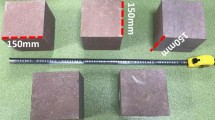Abstract
The ultrasonic method and destructive test were combined to examine sandstone specimens taken from underground construction field in the Mount Taibai of Qinling Mountains, middle part of China. Staged moduli of the four stages during the uniaxial compression of sandstone after temperature varying from 25 to 1,000 °C were defined, through which the complete stress–strain curves of sandstone were studied quantitatively. Thermal damage of sandstone after different high temperatures was analyzed based on the thermal damage factor (TDF) defined by the modulus of compact stage. The temperature-sensitivity coefficient (TSC) was proposed to describe the sensitivity of TDF to temperature as temperature level varied. Research suggests that the compression process of thermally damaged sandstone is of prominent staged characteristic. The strain of compact stage increases significantly in a near-linear style as temperature rises up. For temperature above 400 °C, the ratio of compaction strain to peak strain increases to more than 50 percent. Changing rules of the four-staged moduli with temperature differs widely, among which the modulus of compact stage has a strong relativity with longitudinal wave velocity. The TDF defined by wave velocity loses sight of the change in density and Poisson’s ratio, avoiding the defect of which, the defining method based on modulus of compact stage is of greater veracity. Within the range of 25–200 °C, the TSC is largest and the thermal damage of sandstone is more sensitive to temperature. The results of this article have some guiding significance to rock engineering in high-temperature environment.












Similar content being viewed by others
References
Brown ET (1981) Suggested methods for determining the uniaxial compressive strength and deformability of rock materials. In: Brown ET (ed) Rock characterization, testing and monitoring—ISRM suggested methods. Pergamon Press, Oxford, pp 113–116
Chaboche JL (1988) Continuum damage mechanics: part I—general concepts. J Appl Mech 55:59–64
Euripedes do Amaral Vargas Jr, Raquel Quadros Velloso, Leonardo Erik Chávez, Luiz Gusmão, Claudio Palmeiro do Amaral (2013) On the effect of thermally induced stresses in failures of some rock slopes in Rio de Janeiro, Brazil. Rock Mech Rock Eng 46:123–134
Goodman RE (1989) Introduction to rock mechanics, 2nd edn. Wiley, London
Hajpál Mónika (2002) Changes in sandstone of historical monuments exposed to fire or high temperature. Fire Techonol 38(4):373–382
He MC, Qian QH (2006) Summary of basic research on rock mechanics at great depth. In: Proceedings of the 9th symposium on rock mechanics and engineering. Science Press, Beijing, pp 49–62
Lemaitre J, Dufailly J (1987) Damage measurements. Eng Fract Mech 28:643–661
Levent Tutluoğlu, İbrahim Ferid Öge, Celal Karpuz (2014) Relationship between pre-failure and post-failure mechanical properties of rock material of different origin. Rock Mech Rock Eng (Published online)
Liu QS, Xu XC (2000) Damage analysis of brittle rock at high temperature. Chin J Rock Mech Eng 19(4):408–411
Mazars J (1984) Application de la mécanique de l’endommagement au comportement non linéaire et à la rupture du béton de structure. Thèse d’état, Université Pierre et Marie Curie, France
Prassianakis IN, Prassianakis NI (2004) Ultrasonic testing of non-metallic materials: concrete and marble. Theoret Appl Fract Mech 42:191–198
Sun Q, Zhang ZZ, Xue L, Zhu SY (2013) Experimental research on mechanical behaviors of marble after high temperatures subjected to impact loading. Chin J Rock Mech Eng 32(2):935–942
Sundberg J, Back PE, Christiansson R, Hökmark M, Ländell M, Wrafter J (2009) Modelling of thermal rock mass properties at the potential sites of a Swedish nuclear waste repository. Int J Rock Mech Min Sci 46:1042–1054
Tian H, Thomas Kempka XuNX, Martin Ziegler (2012) Physical properties of sandstones after high temperature treatment. Rock Mech Rock Eng 45:1113–1117
van Manen Saskia M, Wallin Erin (2012) Ground temperature profiles and thermal rock properties at Wairakei, New Zealand. Renew Energy 43:313–321
Vosteen Hans-Dieter, Schellschmidt Rudiger (2003) Influence of temperature on thermal conductivity, thermal capacity and thermal diffusivity for different types of rock. Phys Chem Earth 28:499–509
Wai R, Ky Lo, Rowe RK (1982) Thermal stress analysis in rock with nonlinear properties. Int J Rock Mech Min Sci Geomech Abscr 15(19):211–220
Wan ZJ, Zhao YS, Zhang Y, Wang C (2009) Research status quo and prospection of mechanical characteristics of rock under high temperature and high pressure. Procedia Earth Planetary Sci 1:565–570
Wang YY, Zhang HJ, Huang XC, Qiu YP (2002) Experimental study on whole stress-strain course of marble under the action of high temperature. Chin J Rock Mech Eng 21(s2):2345–2349
Xu JY, Liu S (2013) Effect of impact velocity on dynamic mechanical behaviors of marble after high temperatures. Chin J Geotech Eng 35(5):879–883
Yan ZG, Zhu HH, Deng T, Zeng LJ, Yao J, Qiang J (2006) Experimental study on longitudinal wave characteristics of tuff, granite and breccia after high temperature. Chin J Geotech Eng 28(11):2010–2014
Zhao HB, Yin GZ, Chen LJ (2009) Experimental study on effect of temperature on sandstone damage. Chin J Rock Mech Eng 28(s1):2784–2788
Acknowledgments
The authors acknowledge the support of the National Science Foundation of China (51378497; 51078350).
Author information
Authors and Affiliations
Corresponding author
Rights and permissions
About this article
Cite this article
Wang, P., Xu, J. & Liu, S. Staged Moduli: A Quantitative Method to Analyze the Complete Compressive Stress–Strain Response for Thermally Damaged Rock. Rock Mech Rock Eng 48, 1505–1514 (2015). https://doi.org/10.1007/s00603-014-0648-z
Received:
Accepted:
Published:
Issue Date:
DOI: https://doi.org/10.1007/s00603-014-0648-z




